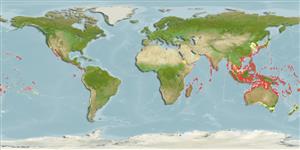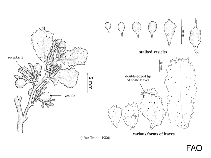Turbinaria ornata (Turner) J. Agardh
Crowded sea bell| Native range | All suitable habitat | Point map | Year 2050 |

|
| This map was computer-generated and has not yet been reviewed. |
| Turbinaria ornata AquaMaps Data sources: GBIF OBIS |
Google image | No image available for this species;
drawing shows typical species in Sargassaceae.
Classification / Names ชื่อสามัญ | ชื่อพ้อง | CoL | ITIS | WoRMS
Phaeophyceae | Fucales | Sargassaceae
Environment: milieu / climate zone / ระดับความลึก / distribution range นิเวศวิทยา
; ระดับความลึก 0 - 53 m (อ้างอิง 102117). Tropical
Distribution ประเทศต่างๆ | พื้นที่จำแนกตาม FAO | ระบบนิเวศหลายระบบ | การปรากฏขึ้น,การเกิดขึ้น,พบ | การแนะนำ
Indo-Pacific: from Eritrea to South Africa to Madagascar and India, including Western Australia, Andaman, Nicobar and Christmas Islands and from China to the South China Sea, Australia, including Federated States of Micronesia, Fiji, and French Polynesia; from east to Chile, including American Samoa, Samoan Archipelago, Cook and Hawaiian Islands.
Length at first maturity / ขนาด / Weight / Age
วัยเจริญพันธุ์: Lm ? range ? - ? cm
Short description สัณฐานวิทยา
Life cycle and mating behavior วัยเจริญพันธุ์ | การสืบพันธุ์ | การวางไข่ | Eggs | ความดกของไข่ | Larvae
Main reference
อ้างอิง | ผู้ประสานงาน | ผู้ร่วมมือ
Guiry, M.D. and G.M. Guiry. 2009. (อ้างอิง 80701)
IUCN Red List Status
(อ้างอิง 130435: Version 2024-2)
CITES status (อ้างอิง 108899)
CMS (อ้างอิง 116361)
Threat to humans
Human uses
การประมง: การค้า
| FishSource |
เครื่องมือ
ข้อมูลเพิ่มเติม
องค์ประอบของอาหาร
การบริโภคอาหาร
ผู้ล่า
Max. ages / sizes
Length-weight rel.
Length-length rel.
Length-frequencies
Mass conversion
อุดมสมบรูณ์
วัยเจริญพันธุ์
ความดกของไข่
การวางไข่
Eggs
Egg development
Larvae
แหล่งที่มาจากอินเตอร์เน็ต
BHL | BOLD Systems | CISTI | DiscoverLife | FAO(Publication : search) | Fishipedia | GenBank (genome, nucleotide) | GloBI | Gomexsi | Google Books | Google Scholar | Google | PubMed | AlgaeBase | แผนภูมิชีวิตแบบต้นไม้ | Wikipedia (Go, ค้นหา) | บันทึกทางด้านสัตววิทยา



